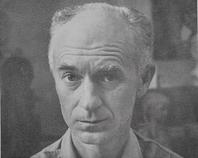
Ernie Pyle
WRITER
The two greatest American war correspondents of World War II were Edward R. Murrow on radio and Ernie Pyle in print. Murrow is more famous today because he survived the war to do some of the best television journalism in the early days of that medium. However, during the war, Pyle was more popular, especially among the GIs at the front. He made a point of staying with the GIs, sharing their food, their fears and homesickness, and getting to know them better than any other correspondent. A great restlessness drove Pyle. A few months before graduating, he dropped out of Indiana University's journalism school to work at a small-town newspaper. In 1932, after nine years as an editor, he quit to become a roving correspondent in Depression-era America. As he later did with the GIs, he lived among the downtrodden and the survivors of the Depression and told America about them. His simple, vivid writing made readers believe they personally knew the people he wrote about. When the war broke out, he went to London and wrote from the locals' homes and the bomb shelters during the Blitz. From there he went to North Africa where he began his close association with the GIs. Through his writing, people on the home front felt a little closer to their sons and fathers and brothers across the ocean, and grew to know their lives in the foxholes. From North Africa he went with the GIs to Sicily, Italy and France. His writing won him several journalism awards, including the 1944 Pulitzer Prize. A few months after D-Day, fatigue caught up with him. He apologetically returned to America to rest, but not for long. Restlessnes and a sense of duty drove him to return to the front lines, this time with the Marines in the Pacific Theater. He joined the Marines at Iwo Jima and followed them to Okinawa. Hearing about a new tank destroyer being used by the Army's 77th division, on Ie Shima Pile decided to get a look. He went ashore on April 17, 1945. On the morning of the 18th Pile hitched a ride with Lieutenant Colonel Joseph B. Coolidge (commanding officer of the 305th Infantry Regiment, 77th Infantry Division), and three other men who were looking for a new location for his regimental headquarters. At about ten o'clock, traveling along a road that had previously thought to have been cleared, a Nambu machine gunner opened up on their jeep. All of the men leaped out of the jeep into a ditch along the road. After a moment Pyle raised his head seeing Coolidge he smiled and said "Are you all right?" At that instant the machine gunner opened up again striking Pyle in the left temple instantly killing him. He was buried with his helmet on in a long row of graves among other soldiers with an infantry private on one side and a combat engineer on the other. At the ten-minute service, the Navy, Marine Corps, and Army were all represented. Pyle was later reburied at the Army cemetery on Okinawa, then moved to the National Memorial Cemetery of the Pacific located in Honolulu. When Okinawa was returned to Japanese control after the war, the Ernie Pyle monument was one of only three American memorials allowed to remain in place. Pyle was among the few American civilians killed during the war to be awarded the Purple Heart.
-
When was
Ernie Pyle born?
Ernie Pyle was born on Friday, August 3, 1900
-
Where was
Ernie Pyle born?
Ernie Pyle was born in Dana, Indiana, USA
-
How old was
Ernie Pyle when they died?
Ernie Pyle was 45
-
When did Ernie Pyle die?
Ernie Pyle died on
Wednesday, April 18, 1945
Follow Us